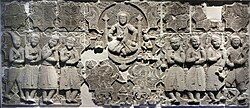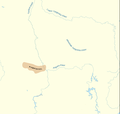Xiongnu, also referred to as Xiong-nu or Hsiung-nu, is the language(s) presumed to be spoken by the Xiongnu, a people and confederation which existed...
30 KB (3,066 words) - 18:21, 17 June 2025
The Xiongnu /kshjõn'nju/ (Chinese: 匈奴, [ɕjʊ́ŋ.nǔ]) were a tribal confederation of nomadic peoples who, according to ancient Chinese sources, inhabited...
193 KB (22,505 words) - 15:13, 22 June 2025
to the Xiongnu confederation, whose ruling elite may have spoken a "southern Yeniseian" language similar to the now extinct Pumpokol language. The Jie...
54 KB (5,029 words) - 05:51, 2 June 2025
several hypotheses about their language) Xiongnu - the language or languages of the Xiongnu (may be the same as the Hunnic language, a closely related one, or...
41 KB (2,572 words) - 22:01, 28 April 2025
and Alexander Vovin have proposed that the Xiongnu, and possibly the European Huns, spoke a Yeniseian language such as an ancestor of Ket. Hyun Jin Kim...
20 KB (2,303 words) - 21:13, 24 June 2025
Turkic peoples (category CS1 Romanian-language sources (ro))
certain about the Xiongnu language(s), it seems likely that at least a considerable part of Xiongnu tribes spoke a Turkic language. Some scholars believe...
199 KB (21,511 words) - 20:24, 9 June 2025
The Han–Xiongnu Wars or Sino–Xiongnu Wars, were a series of military conflicts fought over two centuries (from 133 BC to 89 AD) between the agrarian Chinese...
86 KB (10,534 words) - 16:34, 18 June 2025
Origin of the Huns (category Xiongnu)
physical descent of the Huns from the Xiongnu and that they had shared the same language. While the theory of Xiongnu origins remained popular, a number...
66 KB (8,779 words) - 21:03, 24 June 2025
Huns (category Articles containing Ancient Greek (to 1453)-language text)
de Guignes became the first to propose a link between the Huns and the Xiongnu people, who lived in northern China from the 3rd century BC to the late...
116 KB (15,294 words) - 01:30, 24 June 2025
Touman (category Xiongnu)
the Xiongnu tribal confederation, reigning from c. 220–209 BCE, directly preceding the formation of the Xiongnu empire. Competing with the Xiongnu for...
5 KB (511 words) - 10:57, 5 June 2025
Yeniseian languages. A family including the Xiongnu language and languages which are thought to be closely related to it. Para-Yeniseian Xiongnu? Hunnic...
3 KB (179 words) - 15:52, 17 November 2024
Wusun (category Articles containing simplified Chinese-language text)
culture JIN YUEZHI Subeshi Wusun SELEUCID EMPIRE MAURYA EMPIRE HAN DYNASTY XIONGNU PTOLE- MIES MEROË Scythians Sarma- tians The Wusun (/ˈwuːsʌn/ WOO-sun)...
59 KB (6,839 words) - 23:56, 26 May 2025
Five Barbarians (category Articles containing Chinese-language text)
categorized as the Five Barbarians were: Xiongnu Jie Xianbei Qiang Di Of these five tribal ethnic groups, the Xiongnu and Xianbei were nomadic peoples from...
25 KB (3,313 words) - 17:19, 18 June 2025
Han dynasty (category Articles containing traditional Chinese-language text)
campaigns to quell the Xiongnu. The Xiongnu were eventually defeated and forced to accept a status as Han vassals, and the Xiongnu confederation fragmented...
156 KB (17,741 words) - 04:10, 17 June 2025
Modu Chanyu (category CS1 German-language sources (de))
234–174 BCE) was the son of Touman and the founder of the empire of the Xiongnu. He came to power by ordering his men to kill his father in 209 BCE. Modu...
23 KB (2,877 words) - 03:12, 2 June 2025
Tiele people (category Articles containing Chinese-language text)
as Chile. Chinese take them as Gaoche Dingling. Their language, in brief, and Xiongnu [language] are the same yet occasionally there are small differences...
47 KB (7,060 words) - 23:10, 17 June 2025
Dingling (category Articles containing Chinese-language text)
SELEU- CIDS PTOLE- MIES PARTHIAN EMPIRE SUNGAS SATAVA- HANAS HAN DYNASTY XIONGNU The Dingling were an ancient people who appear in Chinese historiography...
31 KB (3,994 words) - 16:04, 27 May 2025
unclassified extinct language formerly spoken in northeast China during the Later Zhao dynasty by the Jie people, who were formerly part of the Xiongnu confederation...
8 KB (778 words) - 03:23, 25 March 2025
Yeniseian people (category Articles containing Pumpokol-language text)
northernmost expansion of the language family. This migration possibly occurred as a result of the fall of the Xiongnu confederation, which, according...
21 KB (2,366 words) - 12:48, 23 June 2025
Military of the Han dynasty (category CS1 Chinese-language sources (zh))
increased to face the military challenges presented by the Xiongnu during the Han–Xiongnu Wars and other opponents during the Southward expansion of the...
112 KB (12,846 words) - 13:24, 10 February 2025
Turkic history (category CS1 Turkish-language sources (tr))
(2005). 阿尔泰共同语、匈奴语探讨 [On Altaic Common Language and Xiongnu Language]. Yu Yan Yu Fan Yi 语言与翻译(汉文版) [Language and Translation] (2). ISSN 1001-0823. OCLC 123501525...
56 KB (5,840 words) - 02:33, 10 June 2025
Jie people (redirect from Chieh language)
also suggests that the Xiongnu spoke a Yeniseian language, further connecting them with the Jie people. Among the Yeniseian languages, Jie is hypothesized...
20 KB (2,585 words) - 07:59, 24 June 2025
Yuezhi (category Articles containing Chinese-language text)
during the 1st millennium BC. After a major defeat at the hands of the Xiongnu in 176 BC, the Yuezhi split into two groups migrating in different directions:...
77 KB (8,873 words) - 20:06, 15 June 2025
the name of the Xiōngnú ruling house as PT *Alayundluğ /alajuntˈluγ/ 'piebald horse clan.' The earliest known texts in a Turkic language are the Orkhon...
63 KB (7,162 words) - 08:22, 24 June 2025
Rouran Khaganate (category CS1 uses Chinese-language script (zh))
"as a Wei servitor". Primary Chinese-language sources Songshu and Liangshu connected Rouran to the earlier Xiongnu (of unknown ethnolinguistic affiliation)...
69 KB (6,356 words) - 08:57, 23 June 2025
Xianbei (redirect from Xianbei language)
engaging in the struggle between the Han and Xiongnu, culminating in the Xianbei replacing the Xiongnu on the Mongolian Plateau. In the mid-2nd century...
80 KB (9,255 words) - 03:33, 2 June 2025
Donghu people (category CS1 Russian-language sources (ru))
were first recorded from the 7th century BCE and was taken over by the Xiongnu in 150 BCE. They lived in northern Hebei, southeastern Inner Mongolia and...
46 KB (5,681 words) - 15:12, 15 June 2025
Huyan (category Xiongnu)
*hɑ-janH/B) was a noble house that led the last remnants of the Northern Xiongnu to Dzungaria in the second century after the Battle of the Altai Mountains...
5 KB (546 words) - 18:05, 2 May 2025
Consciously devised language Endangered language – Language that is at risk of going extinct Ethnologue#Language families Extinct language – Language that no longer...
34 KB (302 words) - 16:26, 15 June 2025
since the 18th century. It shares many features with the ancient Xiongnu and Jie languages, and according to Alexander Vovin, Edward Vajda, and Étienne de...
13 KB (720 words) - 02:09, 28 May 2025
















